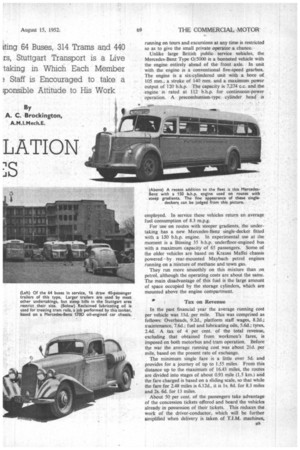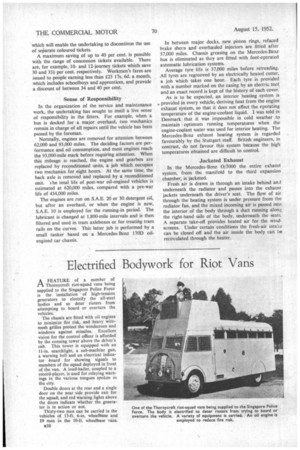STUTTGART'S LATION PREFERS BT RC
Page 42

Page 43

Page 44

If you've noticed an error in this article please click here to report it so we can fix it.
ALTHOUGH the transport picture in Stuttgart is predominated by trams, the impact of bus services on the travelling public has given the operator, Stuttgarter Strassenbahnen, A.G., much to think about. For although only 64 buses are in operation compared with 314 two-axled tramcars and 440 trailers, the inhabitants of Stuttgart show a marked preference for the buses.
Modernization of the tram system with two-unit trams with a total capacity of 200 passengers is promised for the near future. Nevertheless, the official.; of the undertaking admit that popular demand may force them to replace many tram services by buses.
... Like some British municipal undertakings, the Stuttgart system cannot obtain assistance from the municipal exchequer in the event of deficits being incurred. The possibility of curtailing the tram service is regarded as economically hazardous.
Of the 64 buses in service, most of which are Mercedes-Benz Type 0/5000 single-deckers, 16 normally run with trailers. Almost all the buses are used on feeder services to the tram system.
Cost-capacity Ratio .
At peak hours each tram pulls two trailers, and it has been proved that running costs correspond approximately in inverse proportion to the number of passengers carried per driven vehicle. Needless to say, the maximum-capacity three-unit tram trains are run on the most congested routes, so that the cost per passenger is very much lower than the equivalent cost on the bus services. To maintain this relationship, bus fares are normally double the tram rate for an equivalent distance, although one-man operation is almost universal on the buses in contrast to the trams. '
Last year, the buses covered 11m. miles and the trailers approximately 240,000 miles. The number of passengers carried equalled 3im. Except in off-peak periods, the bus-trailer combinations are operated with a crew of two—driver and conductor. Smaller trailers than normal are employed, seating only 40 passengers. The choice of this size of trailer was influenced by the hilly nature of the district. Not only are the drivers required to drive.the buses and collect the fares, but they are also expected to spend two hours each day at work in the workshops assisting the full-time mechanics. It is considered an advantage if drivers have a knowledge of technical matters and of overhaul procedure, in the interests of vehicle performance and life. The arrangement whereby the drivers' duty schedules are planned to allow for the time spent in the workshop is popular and improves the standard of maintenance. The drivers find the break from operational activity interesting and they learn to appreciate the mechanics' point of view on reducing wear and tear.
The Mercedes-Benz single-deckers carry' 40 seated and 20 standing passengers. They are 34 ft. 8 ins, long and slightly aver 8 ft. wide. They weigh 7 tons unladen. Power-operated sliding doors are provided front and rear, the entry being alongside the driver's seat, which is not separated from the passenger compartment so as to permit the. maximum amount of circulation space for passengers waiting to pay their fares. All the seats are comfortably upholstered.
This is probably because five vehicles are operated on tours and excursions. Any vehicle in the fleet may be chosen for this work, but the number of vehicles running on tours and excursions at any time is restricted so as to give the small private operator a chance.
Unlike large British public service vehicles, the Mercedes-Benz Type 0/5000 is a bonneted vehicle with the engine entirely ahead of the front axle. In unit with the engine is a conventional five,Speed gearbox. The engine is a six-cylindered unit with a bore of 105 mm., a stroke of 140 mm, and a maximum, power output of 120 b.h.p. The capacity is 7,274 c.c. and the engine ' is rated at 112 b.h.p. for continuous-power operation. A precombustion-type cylinder head is employed. In service these vehicles return an average fuel consumption of 8.3 m.p.g.
For use on routes with steeper gradients, the undertaking has a new Mercedes-Benz single-decker fitted with a 150 b.h.p. engine. In experimental use at the moment is a Bussing 35 b.h.p. underfloor-engined bus with a maximum capacity of 65 passengers. Some of the older vehicles are based on Krauss Maffei chassis powered --by rear-mounted Maybach petrol engines running on a mixture of methane and town gas.
They run more smoothly on this mixture than on petrol, although the operating costs are about the same. The main disadvantage of this fuel is the large amount of space occupied by the storage cylinders, which are mounted above the engine compartment.
Tax on Revenue
In the past financial year the average running cost per vehicle was 33d. per mile. This was comprised as follows: Overheads, 9.2d., platform staff wages, 8.2d.; 23aintenance, 7.6d.; fuel and lubricating oils, 5.64; tyres, 2.44 A tax of 4 per cent. of the total revenue, excluding that obtained from workmen's fares, is imposed on both motorbus and tram operation. Before the war the average running cost was about 21 d. per mile, based on the present rate of exchange.
The minimum single fare is a little over 5d. and provides for a journey of up to 1.55 miles. From this distance up to the maximum of 16.43 miles, the routes are divided into stages of about 0.93 mile (1.5 km.) and the fare charged is based on a sliding scale, so that while the fare for 2.48 miles is 6.12d., it is Is. 8d. for 8.3 miles and 2s. 6d. for 13 miles.
About 50 per cent. of the passengers take advantage of the concession tickets offered and board the vehicles already in possession of their tickets. This reduces the work of the driver-conductor, which will be further simplified when delivery is taken of T.I.M. machines,
which will enable the undertaking to discontinue the use of separate coloured tickets.
A maximum saving of up to 40 per cent. is possible with the range of concession tickets available. There are, for example, 10and 12-journey tickets which save 30 and 331 per cent. respectively. Workmen's fares are issued to people earning less than £25 17s. 6d. a month, which includes schoolboys and apprentices, and provide a discount of between 34 and 40 per cent.
Sense of Responsibility
In the organization of the service and maintenance work, the undertaking has sought to instil a live sense of responsibility in the fitters. For example, when a bus is docked for a major overhaul, two mechanics remain in charge of all repairs until the vehicle has been passed by the foreman.
' Normally, engines are removed for attention between 62,000 and 93,000 miles. The deciding factors are performance and oil consumption, and most engines reach the 93,000-mile mark before requiring attention. When this mileage is reached, the engine and gearbox are replaced by reconditioned units, a job which occupies two mechanics for eight hours. At the same time, the back axle is removed and replaced by a reconditioned unit. "the total life of post-war oil-engined vehicles is estimated at 620,000 miles, compared with a pre-war life of 434,000 miles.
The engines are run on S.A.E. 20 or 30 detergent oil, but after an overhaul, or when the engine is new, S.A.E. 10 is employed for the running-in period. The lubricant is changed at 1,800-mile intervals and is then filtered and used in tram axleboxes or for treating tram rails on the curves: This latter job is performed by a small tanker based on a Mercedes-Benz 170D oilengined car chassis.
In between major docks, new piston rings, refaced brake shoes and overhauled injectors are fitted after 37,000 miles. Chassis greasing on the Mercedes-Benz bus is eliminated as they are fitted with foot-operated automatic lubrication systems.
Average tyre life is 37,000 miles before retreading. All tyres are regrooved by an electrically heated cutter, a job which takes one hour. Each tyre is provided with a number marked on the casing by an electric tool and an exact record is kept of the history of each cover.
As is to be expected, an interior -heating system is
• provided in every vehicle, deriving heat from the engine exhaust system, so that it does not affect the operating temperature of the engine-coolant liquid. I was told in Denmark that it was impossible in cold weather to maintain optimum running temperatures when the engine-coolant water was used for interior heating. The Mercedes-Benz exhaust heating system is regarded favourably by the Stuttgart staff. British engineers, in contrast, do not favour this system because the high temperatures obtained are difficult to control.
Jacketed Exhaust
In the Mercedes-Benz 0/5000 the entire exhaust system, from the manifold to the third expansion chamber, is jacketed.
Fresh air is drawn in through an intake behind and underneath the radiator and passes into the exhaust jackets underneath the driver's seat. The flow of air through the heating system is under pressure from the radiator fan, and the mixed incoming air is passed into the interior of the body through a duct running along the right-hand side of the body, underneath the seats. A separate take-off provides heated air for the windscreens. Under certain conditions the fresh-air inta:te can be closed off and the air inside the body can be recirculated through the heater.




















































































